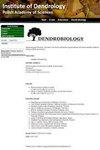从叶片形态推断的欧亚西南部榛属植物的分类关系和种群分化
IF 1.8
4区 农林科学
Q2 FORESTRY
引用次数: 2
摘要
遗迹树种Zelkova abelicea和Z.sicula(Ulmaceae)分别出现在克里特岛和西西里岛。Zelkova abelicea生长在克里特岛山区的大约40个地方,而Z.scicula只在西西里岛的两个林分中发现。我们比较了这两个物种叶片的25个形态特征,并使用统计学方法(Tukey’st、判别分析、主成分分析、聚类)揭示了这两种植物之间的差异、它们与第三个泽尔科娃西南欧亚种(Z.carpinifolia)的关系以及不同茎型叶片之间的差异。我们的研究首次对位于该属当前地理范围西部边缘的三种泽尔科娃物种进行了生物特征比较分析。我们发现,这两个物种在叶型特征和叶变异水平方面都有所不同。泽尔科娃(Zelkova carpinifolia)与大叶泽尔科瓦(Z.abelicea。后一项发现支持了最近分子研究的结果,暗示了西葫芦的杂交起源。大叶泽尔科娃(Zelkova abelicea)、细叶泽尔科娃树(Z.sicula)和卡氏叶泽尔科娃(Z.carpinifolia)在叶片特征和表型变异水平上存在差异。本文章由计算机程序翻译,如有差异,请以英文原文为准。
Taxonomic relationships and population differentiation of the south-western Eurasian Zelkova species inferred in leaf morphology
The relict tree species Zelkova abelicea and Z. sicula (Ulmaceae) occur in Crete and Sicily, respectively. Zelkova abelicea grows in approximately 40 localities in the mountains of Crete, while Z. sicula has been found in only two stands in Sicily. We compared 25 morphological characters of the leaves of both species and used statistical methods (Tukey’stest, discrimination analysis, principal component analysis, agglomeration) to reveal the differences between these two species, their relation to Z. carpinifolia (the third Zelkova south-west Eurasian species), and between the leaves from different shoot types. Our study represents the first comparative biometric analysis of the three Zelkova species localized in the western edge of the current geographic range of the genus. We found that the species differed from each other both, in terms of leaf form characters and level of leaf variation. Zelkova carpinifolia was clearly different from Z. abelicea, while the two populations of Z. sicula, SIB and SIA, were more similar to Z. carpinifolia and Z. abelicea, respectively. The latter finding supports the results of recent molecular studies suggestingt he hybrid origin of Z. sicula. Zelkova abelicea, Z. sicula and Z. carpinifolia differ each other in the leaf characteristics and level of phenotypic variation.
求助全文
通过发布文献求助,成功后即可免费获取论文全文。
去求助
来源期刊

Dendrobiology
农林科学-林学
CiteScore
2.20
自引率
11.10%
发文量
17
审稿时长
>12 weeks
期刊介绍:
Dendrobiology publishes original research articles and review articles related to the biology of trees and shrubs.
 求助内容:
求助内容: 应助结果提醒方式:
应助结果提醒方式:


